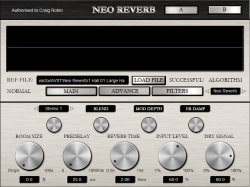 Sound Magic has introduced Neo Reverb – a reverb that they say combines the realism of a convolution reverb with the flexibility of a algorithmic reverb.
Sound Magic has introduced Neo Reverb – a reverb that they say combines the realism of a convolution reverb with the flexibility of a algorithmic reverb.
Neo Reverb features around 40 controls allowing you to tweak the sounds. You also get over 100 converted Algorithm IRs (called REF Files) which cover different types of space, such as Hall, Room, Plate, Chamber, Concert Hall, etc.
Features
- Internal 64-bit floating point precision.
- All-Purposed Reverb contains 8 Algorithms for different spaces, including, Hall, Concert Hall, Room, Plate, Chamber, Ambience, Space and etc.
- Innovative Hybrid Convolution and Algorithm Reverb Engine.
- Innovative Cascade True Stereo technology.
- Powerful modulation system helps to achieve a dynamic sound.
- Over 40 in depth controls on the Reverb.
- Over 130 algorithm IRs in 6 different categories for your uses.
- Innovative Dual Cores Controls let users compare different settings quicker.
- Support up to 32-bit/384kHz resolution.
About Neo Reverb
Here’s what they have to say about Neo Reverb:
Neo Reverb has a new model, the ‘Ba gua Model’. This new model is different from the Schroeder/Moore Model, adding the ability to generate millions of early reflections, and then holding thousands of delay lines for at least 15 seconds. A typical Algorithm Reverb only utilizes hundreds of early reflections. This huge difference puts a lot of pressure on your CPU and RAM. Further, in order to avoid the static sound of most convolution reverbs, you need to modulate these millions of Early Reflections in real time. That’s even more of a challenge for your typical computer setup.
To overcome this issue, Sound Magic uses ASM (assembly language) in its core. ASM is the native language of your CPU and it’s far more efficient than common C++. By doing so, Neo Reverb keeps your CPU usage around 20%, while giving you 200 times the reverb calculations of a typical algorithm reverb.
Another great obstacle to making software reverb sound as good as hardware reverb is that of efficiently using the cache. Remember that a reverb has to hold thousands of delay lines for a few seconds. This fills up the cache quickly and it’s easy to run out of resources. Today’s CPUs typically have only an 8MB cache fast enough (usually L2/L3 Cache of the CPU) to do this hard job, but the FPGA inside those hardware reverbs have at least 128MB – or even 256MB.
Sound Magic has developed an innovative Cache Compress and Reallocate Technology that will efficiently compress the data in the cache in real time, making the 8MB cache have the efficiency of 200MB. Neo Reverb can easily hold thousands of delay lines for 15 seconds which produces a really smooth reverb tail.
Another breakthrough technology that Neo Reverb uses is the Cascade True Stereo technology, which emulates the natural blending process when sound resonates in a huge hall. In a real space, such as a concert hall, the left and right channel sounds are blended together, but it is a continuous process, not a one time blend. Traditional True Stereo tends to blend them immediately but Sound Magic Cascade True Stereo technology makes this blending an ongoing process in real time, creating a beautiful spatial sound.
Neo Reverb is available starting at 99 Euro for the standard version and 199 Euro for the pro version. See the Supreme Piano site for details.
